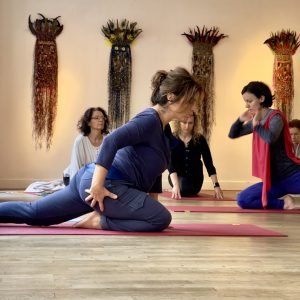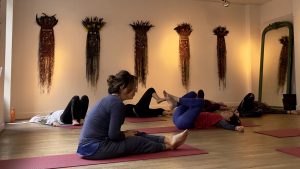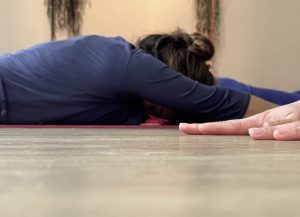This interview was published in the Journal de l´IFY (2023)
The Fasciae, a way into inner yoga
Interview with Lina Franco Morrison conducted by Sylvie Prioul.
Photo Credit: COLL Lina Franco / Studio Climats
The word yoga means ‘junction, union’. Like yoga, fasciae work on deep structural coherence, awakening feelings of real perceptions, since the fasciae are themselves real. Something of that structural permanence can be experienced in āsana.
Lina Franco has undertaken work on what she calls ‘the territory of the fasciae’, fibrous membranes which surround and connect anatomical structures: organs, muscles, bones, arteries. This research has fuelled her personal practice and has led to developments in her teaching.
Her research emerged from constant exchanges with Carla Stecco, orthopedic specialist and Professor of Human Anatomy and the Science of Movement at the University of Padua and author of the Atlas fonctionnel du système fascial humain (Tita Editions). This research has nurtured Lina’s personal practice and brought about an evolution in her teaching.
Which main themes are you currently working on?
LF: Within the framework of yoga teaching it seems to me there are two themes which intersect: one that concerns the issue of health (called svastha in Sanskrit, that which is stable in the Self) and one that concerns the question of happiness (ānanda). Between these two themes it seems to me that it is of utmost importance to recall that some things are ‘absolutely unfavorable’ to both health and happiness. I feel that yoga can help us to look closely at what is ‘absolutely unfavorable’ and use it to improve, get rid of, look after, take responsibility for, understand and transform. This idea of something being ‘absolutely unfavourable’ interested me a lot as it opens up the possibility of studying human beings, specifically their physio-biological and mental functioning in connection with the surrounding environment.
‘Willing liberates’ and I think that through yoga, through the texts, something can be freed up every day on the mat. The process that makes it possible to free oneself from what is deeply unfavorable is work that has to be done every single day and that concerns both health and happiness.
To come to the fasciae and what I call the ‘postural laboratory of movement’. The fasciae are communicating, protective structures. They contribute to helping yoga practitioners develop their perception of a more consistent body, less broken up, less segmented, separated; we no longer talk about ‘organs’ or ‘muscles’, but in terms of a territory that includes bigger areas. These ‘tectonic’ parts are constantly in communication with each other. That completely transforms the way you perceive yourself and are in the world. Posture is no longer an arm lifting up, a part of the body bending or rotating: we are outside classical anatomical movement.

How did you come to carry out this research?
I took a particular interest in the fasciae in the head and diaphragm, which enabled me to explore the classical breathing techniques from the perspective of these structures. In a group class or 1:1, I observe the body breathing whilst keeping in mind the fasciae. That enables me to see things differently.
When I worked on the energetic representation of the body on the basis of the Taittirīya upaniṣad, I found there the notion of the ‘kośa’ and I feel that in the upaniṣad there is an inkling of the existence of the fasciae. These are frameworks that at a certain point come together. And then there was a program on the channel Arte (‘Fascinants fascias : les alliés secrets de notre organisme’), which encouraged me to study the subject more deeply.
That also corresponded with questions I was asking myself about the teaching and transmission of postures, and how we talk about the body. I had noticed the limitations of the anatomical approach which gives us a ‘scattered’ representation of the body and doesn’t take into account what is going on between the different elements that make it up, this fascinating structure that is the body, an elastic, flexible, reformable and continuous system. What I wanted to do was for the body to be felt differently than just through a classical anatomical filter, which is nevertheless necessary. Fasciae offer a different view of pain or injury. What took me in this direction was also an accident I had that required several months of physiotherapy based on fascia therapy. All of that helped to focus my attention on this topic.
How can we connect the fasciae and health?
In the study and application of the fasciae that I am pursuing, I see them as a nimitta (intelligent cause). Many students come to yoga because they have health problems to solve. This predominance of the question of ‘health’ takes up a bit too much space in comparison to the ’happiness’ aspect, which I mentioned previously and seems to me to be neglected. And I think that the fasciae also enable us to come back to the question of happiness. The Yoga-sūtra bring us face to face with experiences that often remain abstract: prānāyāma, samādhi, kaivalya… On the other hand, through the effects that some experiences can have on an individual’s deep, fundamental balance, we can see things differently: by feeling that there is something in the flesh that guarantees a sort of structural permanence, what happens to confidence, stability, rootedness… It’s not something that is being played out only in terms of support, contact, alignment or axis. There comes a point when we move away from these fields, asking ourselves: ‘but what is all that based on when it comes down to it?’ The fasciae give us a perception of what scientists call ‘structural permanence’: there is an embodied stability linked to the idea of presence and what is possible. The more we can move towards that structural permanence, the more we develop the stability of volumes, establishment in the living world, presence, which all fits together very differently, not purely physiologically and in terms of joints.
How can this work be integrated into practice?
This is a key element that frequently comes up in yoga sessions. I’ve also led three workshops on the fasciae. I always start with postural work, as the body remains the way in, beyond possible resistance, which channels that which is ‘absolutely unfavorable’. The most recent workshop was devoted to twists, the vṛtti, which I worked on in parallel with the citta vṛtti, our mental contortions and resistances. After that workshop, participants wanted to share their experiences. Someone with neck pain made a connection between their pain and two deaths: following the work with the shoulder girdle and nape of the neck, she felt that twisting and pain in the membrane when it is tense. ‘What is twisting in the flesh is already twisted in the mind’: saying that provided a trigger that set in motion feelings and the psyche, as if an emotion-information, a primary emotion had been released.

You quoted Nietzsche and his maxim ‘Willing liberates’. Can you tell us why?
It’s about wanting to look at things closely: looking differently at how we function, how we are made, how we work, how we feel and share things liberates and transforms us. The fasciae around the diaphragm are a good illustration of that. The breath enables us to get closer to what cannot be said or touched. If we think about the fasciae of the head and diaphragm, we are in the envelope of air and breath of the skull, which transmits very powerful neurological messages and enables us to have experiences in our postural and energy (prāṇāyāma) practices that reveal things.
As Tara Michaël says, yogis are ‘spotters’ that get onto the mat in order to liberate birds, the great birds of the breath, thanks to the bandha. Understanding the fasciae brings us a new understanding of the breath that can be liberated during practice through cranial breathing.
Suggesting this kind of work to students means asking them to leap into the unknown. But after the initial reaction of surprise followed by curiosity because the general presentation touched them, they are drawn towards experience. Something deep happens each time. Having taught in the classical way for a long time, I think there’s another way in there.
Fasciae are ‘extraordinary’ structures.
With fasciae, there’s a revolution in language. We don’t talk about organs any more, but ‘zones’. Personally, I prefer the word ‘territories’. This semantic shift gives a different representation of the body. With these ribbons and surfaces, you imagine your body differently. Our perception and our experiences are transformed by it and new images become established.
That has changed the way I guide students into postures. For example, I create links by following the pathways of fasciae, and no longer by following, for example, the alignment of head and pelvis. I guide towards new territories… Before, I used to talk a lot about alignment; now I talk more about contact, swaying, balancing, pressure, volume, cracks. And even with the breath, rather than talking about ‘suspension’, I prefer to say interval, the breath’s empty, suspended or falling drop. I guide very differently, which was a sort of revolution for my students. They have had to trust me, let themselves be taken away to new areas. The change occurred in language, in the reference points I give and in the global representation of the body.

How do you reconcile the teaching you received and this new research?
I don’t want to deny the teaching I have received. I have built the whole of my practice on the encounter between tradition – I am constantly surprised by the relevance of the fundamental yoga texts – and the transversality of contributions, which seems to me to be the main quality of modernity, which brings in science and neuroscience.

